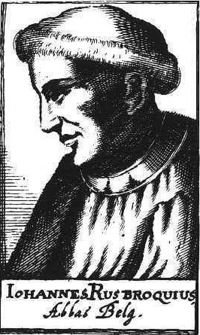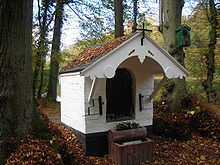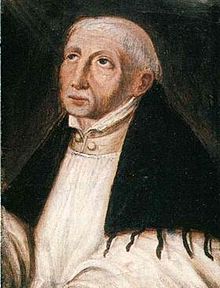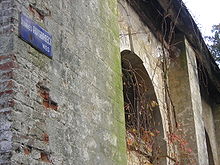- John of Ruysbroeck
-
This article is about the 14th-century mystic. For the 15th-century architect, see Jan van Ruysbroek (architect).
The Blessed John of Ruysbroeck (Dutch: Jan van Ruusbroec, Jan (or Johannes) van Ruysbroeck, Dutch pronunciation: [jɑn vɑn rœ.y̯zbruk, ry.zbruk]) (1293 or 1294, Ruisbroek – 2 December 1381, Groenendaal) was one of the Flemish mystics.
John of Ruysbroeck (in the Flemish original, Jan van Ruusbroek) 
The blessed John of RuysbroeckBorn c1293–4
Ruisbroek, near BrusselsDied 2 December 1381
Groenendael, near BrusselsHonored in the Catholic Church Beatified 1903 by Pope Pius X Contents
Life
Until his ordination
John had a devout mother, who brought him up in the Catholic faith; of his father we know nothing. John's surname, Van Ruusbroec, is not a surname in the modern sense but a toponym that refers to his native hamlet; modern-day Ruisbroek near Brussels (compare John of Salisbury or Democritus of Abdera).
At the age of eleven he left his mother, departing without leave or warning, to place himself under the guidance and tuition of his uncle, Jan Hinckaert, a canon of St. Gudule's, Brussels. Hinckaert was living according to his Apostolic views with a fellow-canon, Francis van Coudenberg. This uncle provided for Ruysbroeck's education with a view to the priesthood. In due course, John was presented with a prebend in St. Gudule's church, and ordained in 1317. His mother had followed him to Brussels, entered a Béguinage there, and died shortly before his ordination.
Priest in Brussels
For twenty-six years Ruysbroeck continued to lead, together with his uncle Hinckaert and Van Coudenberg, a life of extreme austerity and retirement. At that time the Brethren of the Free Spirit were causing controversy in the Netherlands and one of them, a woman named Heilwige Bloemardinne, was particularly active in Brussels, propagating her beliefs chiefly by means of popular pamphlets. Ruysbroeck responded with pamphlets also written in the native tongue (Middle Dutch). Nothing of these treatises remains. The controversy had a permanent effect on Ruysbroeck: his later writings bear constant reference, direct and indirect, to the 'heretical' views expressed in these times, and he always wrote in the country's native language, chiefly with a view to counteracting these writings which he viewed as heretical.
Priest in Groenendaal
The desire for a more retired life, and possibly also the persecution which followed Ruysbroeck's attack on Bloemardinne, induced the three friends to quit Brussels in 1343 for the hermitage of Groenendaal, in the neighbouring Sonian Forest, which was made over to them by John III, Duke of Brabant. The ruins of the monastery are still present in the forest of Soignes.[1]
But here so many disciples joined the little company that it was found expedient to organize into a duly-authorized religious body. The hermitage was erected into a community of canons regular on 13 March 1349, and eventually it became the motherhouse of a congregation, which bore its name of Groenendaal. Francis van Coudenberg was appointed first provost, and Blessed John Ruysbroeck prior. Hinckaert refrained from making the canonical profession lest the discipline of the house should suffer from the exemptions required by the infirmities of his old age; he dwelt, therefore, in a cell outside the cloister and there a few years later died.
This period, from his religious profession (1349) to his death (1381), was the most active and fruitful of Ruysbroeck's career. His fame as a man of God, as a sublime contemplative and a skilled director of souls, spread beyond the bounds of Flanders and Brabant to Holland, Germany, and France. All sorts and conditions of men sought his aid and counsel. A characteristic story was that one day two priests came from Paris to ask his opinion of their spiritual state, to be told: "You are as holy as you wish to be!" [2] His writings were eagerly caught up and rapidly multiplied, especially in the cloisters of the Netherlands and Germany; early in the fifteenth century they are to be found also in England. Among the more famous visitors to Groenendaal mention is made of Johannes Tauler, but though the German preacher certainly knew and appreciated his writings, it is not established that he ever actually saw Ruysbroeck. Gerard Groote in particular venerated him as a father and loved him as a friend. And through Groote, Ruysbroeck's influence helped to mould the spirit of the Windesheim School, which in the next generation found its most famous exponent in Thomas à Kempis.
After death
John's relics were carefully preserved and his memory honoured as that of a saint. When Groenendaal Priory was suppressed by Joseph II in 1783, his relics were transferred to St. Gudule's, Brussels, where, however, they were lost during the French Revolution. John was beatified on 1 December 1908, by Pope St. Pius X.
No authentic portrait of John is known to exist; but the traditional picture represents him in the canonical habit, seated in the forest with his writing tablet on his knee, as he was in fact found one day by the brethren—rapt in ecstasy and enveloped in flames, which encircle without consuming the tree under which he is resting.
After his death, stories called him the Ecstatic Doctor or Divine Doctor, and his views formed a link between the Friends of God and the Brethren of the Common Life, the ideas which may have helped to bring about the Reformation.
Works and philosophy
Of Ruysbroeck's works, the treatise The Seven Steps of the Ladder of Spiritual Love is the one that is currently most-readily available. Of the various treatises preserved, the best-known and the most characteristic is that entitled The Spiritual Espousals. It is divided into three books, treating respectively of the active, the interior, and the contemplative life.
Literally, Ruysbroeck wrote as the spirit moved him. He loved to wander and meditate in the solitude of the forest adjoining the cloister; he was accustomed to carry a tablet with him, and on this to jot down his thoughts as he felt inspired so to do. Late in life he was able to declare that he had never committed aught to writing save by the motion of the Holy Ghost.
In none of his treatises do we find anything like a complete or detailed account of his system; perhaps, it would be correct to say that he himself was not conscious of elaborating any system. In his dogmatic writings he explains, illustrates, and enforces traditional teachings with remarkable force and lucidity. In his ascetic works, his favourite virtues are detachment, humility and charity; he loves to dwell on such themes as flight from the world, meditation upon the Life, especially the Passion of Christ, abandonment to the Divine Will, and an intense personal love of God.
In common with most of the German mystics Ruysbroeck starts from God and comes down to man, and thence rises again to God, showing how the two are so closely united as to become one. He demonstrates inclinations towards Christian universalism in writing that "Man, having proceeded from God is destined to return, and become one with Him again." But here he is careful to clarify his position: "There where I assert that we are one in God, I must be understood in this sense that we are one in love, not in essence and nature." Despite this declaration, however, and other similar saving clauses scattered over his pages, some of Ruysbroeck's expressions are certainly rather unusual and startling. The sublimity of his subject-matter was such that it could scarcely be otherwise. His devoted friend, Gerard Groote, a trained theologian, confessed to a feeling of uneasiness over certain of his phrases and passages, and begged him to change or modify them for the sake at least of the weak. Later on, Jean Gerson and then Bossuet both professed to find traces of unconscious pantheism in his works. But as an offset we may mention the enthusiastic commendations of his contemporaries, Groote, Johannes Tauler, Thomas à Kempis, John of Schoonhoven, and in subsequent times of the Franciscan Henry van Herp, the Carthusians Denis and Laurentius Surius, the Carmelite Thomas of Jesus, the Benedictine Louis de Blois, and the Jesuit Leonardus Lessius. Ernest Hello and especially Maurice Maeterlinck have done much to make his writings known. Ruysbroeck was a powerful influence in developing United Nations Secretary General Dag Hammarskjöld's conception of spiritual growth through selfless service to humanity, as expressed in his book of contemplations called Vägmärken ('Markings').[3]
Ruysbroeck insisted that the soul finds God in its own depths, and noted three stages of progress in what he called the spiritual ladder of Christian attainment: (1) the active life, (2) the inward life, (3) the contemplative life. He did not teach the fusion of the self in God, but held that at the summit of the ascent the soul still preserves its identity.[4] In the Kingdom of the Lovers of God he explains that those seeking wisdom must "flow forth on the waters to all the boundaries of the earth, that is, on compassion, pity and mercy shown to the needs of all men", must "fly in the air of the Rational faculty" and "refer all actions and virtues to the honour of God"; thence (through grace) they will find an "immense and boundless clearness" bestowed upon their mind.[5] In relation to the contemplative life, he held that three attributes should be acquired: The first is spiritual freedom from worldly desires ("as empty of every outward work as if he did not work at all"), the second is a mind unencumbered with images ("inward silence"),and the third is a feeling of inward union with God ("even as a burning and glowing fire which can never more be quenched").[6] His works, of which the most important were De vera contemplatione ("On true contemplation") and De septem gradibus amoris ("On the seven steps of love"), were published in 1848 at Hanover; also Reflections from the Mirror of a Mystic (1906) and Die Zierde der geistlichen Hochzeit (1901).
Books and articles
In translation
- The Spiritual Espousals. Transl. by H. Rolfson, intro. by P. Mommaers, edited by J. Alaerts. Collegeville, Minnesota: Liturgical Press, 1995.
- John Ruusbroec. The Spiritual Espousals and other works. Introduction and translation by James A. Wiseman, O.S.B., preface by Louis Dupré. Mahwah, N.J.: Paulist Press, 1985. [Classics of Western Spirituality] {Includes also: The Sparkling Stone, A Mirror of Eternal Blessedness, and The Little Book of Clarification.} Pages: xvii, 286.
- The Spiritual Espousals. Translation by Eric Colledge. London: Faber and Faber, 1952. Reprint 1983 by Christian Classics.
- The Seven Steps of the Ladder of Spiritual Love. Translated from Flemish by F. Sherwood Taylor, introduced by Joseph Bolland, S.J. London: Dacre Press 1944. Pages: viii, 63.
- The Kingdom of the Lovers of God. Transl. by T. Arnold Hyde. London: Kegan paul, Trench, Trubner, 1919. Pages: xvi, 216.
- The Adornment of the Spiritual Marriage; The Sparkling Stone; The Book of the Supreme Truth. Translation by C. A. Wynschenk. Introduction and Notes by Evelyn Underhill. London: J. M. Dent, 1916.
- The Book of the Twelve Béguines. Transl. from Flemish by John Francis. London, 1913. {First sixteen chapters only.}
- Reflections from the mirror of a mystic, transl. by E.Baillie. London: Thomas Baker, 1905. {Per E.Underhill: short passages paraphrased into Latin by Laurentius Surius (c.1552); but the better version being Flowers of a Mystic Garden, transl. by 'C.E.S.' London, 1912.}
- see Paul Verdeyen below.
Commentary
- Louis Dupre, The Common Life. Origins of Trinitarian Mysticism & Its Development by Jan van Ruusbroec. New York: Crossroad, 1984.
- Paul Mommaers, The Land Within. The Process of Possessing & Being Possessed by God according to the Mystic Jan Van Ruysbroeck. Translated from the Dutch by David N. Smith. Chicago: Fransican Herald Press, 1975.
- Vincent Joseph Scully, A Mediaeval Mystic. A short account of the life and writings of Blessed John Rysbroeck, Canon regular of Groenendael A.D. 1293–1381.... New York: Benziger Brothers, 1911. Pages: xii, 131.
- Evelyn Underhill, Ruysbroeck. London: G. Bell, 1915. Reprint: Kessinger 2003. Pages: ii, 191. Online
- Rik Van Nieuwenhove, Jan Van Ruusbroec. Mystical Theologian of the Trinity, University of Notre Dame, 2003.
- Paul Verdeyen, Ruusbroec and his Mysticism, Collegeville: Liturgical Press/Michael Glazier, 1994, includes a short anthology of his writings; being Ruusbroec en zijn mystiek (Leuven: Davidfonds 1981) as transl. by Andre Lefevere.
- Geert Warnar, Ruusbroec. Literature and Mysticism in the Fourteenth Century [Brill's Studies in Intellectual History]. Brill, 2007.
- Alfred Wautier d'Aygalliers, Ruysbroeck the Admirable. Transl. by Fred Rothwell. London: J. M. Dent & Sons, 1925, & E. P. Dutton, New York, 1925. Reprint: Port Washington, New York: Kennikat, 1969. Pages: xliii, 326.
- Paul Mommaers and Norbert De Paepe (editors), Jan van Ruusbroec: The Sources, Content, and Sequels of his Mysticism. Louvain: Leuven University Press, 1984. [Mediaevalia Lovaniensia, ser.1, stud.12]
- Stephanus Axters, The spirituality of the old Low Countries, London: Blackfriars 1954; being La spiritualité des Pays-Bas: l'evloution d'une doctrine mystique (Louvain 1948), transl. by Donald Attwater. {Axters focuses on Ruusbroec.}
- Paul Mommaers & Jan van Bragt, Mysticism, Buddhist and Christian. Encounters with Jan van Ruusbroec. New York: Crossroad, 1995. [Nanzan studies in religion and culture (Nagoya)]
- Helmut Hatzfeld, "Influence of Ramon Lull & Jan van Ruysbroeck on the Language of Spanish Mystics" Traditio 4: 337–397 (1946).
- Wayne Teasdale, "Ruysbroeck's Mystical Theology" Parts 1 and 2. American Benedictine Review 35:82–96, 35:176–193 (1984).
References in popular culture
Larry Darrell, the main character in W. Somerset Maugham's The Razor's Edge, says: "There are more answers than questions, and lots of people have found answers that were perfectly satisfactory for them. Old Ruysbroeck for one." Maugham, who appears as a character in the novel, says that the mention of Ruysbroeck was his first indication of the kind of journey that Darrell had embarked upon: the search for God.
See also
- Evelyn Underhill's Ruysbroeck for a description of her book and an abstract of its contents.
References
- ^ Michel Erkins. De Priorij van Groenendaal. Gemeentehuis. Jan van Ruusbroecpark. Hoeilaart. 2007.
- ^ Evelyn Underhill introduction to The Adornment of the Spiritual Marriage; The Sparkling Stone; The Book of the Supreme Truth. Translation by C. A. Wynschenk. London: J. M. Dent, 1916. p3
- ^ "[t]he counterpoint to this enormously exposed and public life is Eckhart and Jan van Ruysbroek. They really give me balance and-a more necessary sense of humor." Henry P van Dusen. Dag Hammarskjöld. A Biographical Interpretation of Markings. Faber and Faber. London, 1967. pp49-50
- ^ "Nevertheless neither is this unity one, but each of those established in singular grace and glory hold in themselves unity and their own function in accordance with their own dignity and nobility. But this unity is situated in the mind and in the form of all powers by means of the bond of love." Jan Ruysbroeck. The Kingdom of the Lovers of God. T. Arnold Hyde (trans) Kegan Paul. London, 1919. p134.
- ^ Jan Ruysbroeck. The Kingdom of the Lovers of God. T. Arnold Hyde (trans) Kegan Paul. London, 1919. pp 82-83 and 163
- ^ The Adornment of the Spiritual Marriage; The Sparkling Stone; The Book of the Supreme Truth. Translation by C. A. Wynschenk. Introduction and Notes by Evelyn Underhill. London: J. M. Dent, 1916. pp 89, 94 and 110
External links
- Article from the New Schaff-Herzog Encyclopedia of Religious Knowledge (unedited OCR scan; scroll to bottom of page for start of article)
- Translations of "The Adornment of the Spiritual Marriage", "The Sparkling Stone", and "The Book of the Supreme Truth"
- Translation of "The Book of the Supreme Truth"
- Translation of "The Adornment of the Spiritual Marriage"
- Essay on the 'Friends of God'
- Amherst Manuscript Transcription, 'The Sparkling Stone'
- "Blessed John Ruysbroeck". Catholic Encyclopedia. New York: Robert Appleton Company. 1913. http://www.newadvent.org/cathen/13280c.htm.
- Translation of the last chapter of the "Spiritual Espousals"
- John Ruysbroeck, Blessed at The Original Catholic Encyclopedia
 This article incorporates text from a publication now in the public domain: Herbermann, Charles, ed (1913). "Blessed John Ruysbroeck". Catholic Encyclopedia. Robert Appleton Company.Categories:
This article incorporates text from a publication now in the public domain: Herbermann, Charles, ed (1913). "Blessed John Ruysbroeck". Catholic Encyclopedia. Robert Appleton Company.Categories:- 1290s births
- 1381 deaths
- Flemish writers (before 1830)
- Beatified people
- Christian mystics
- 14th-century venerated Christians
- Belgian Roman Catholics
Wikimedia Foundation. 2010.



